The discovery of the largest single cache of pre-European contact material found north of Mexico (near present-day Spiro, in Eastern Oklahoma) has been shrouded in myth and mystery, which led many to regard it as the craziest, most improbable, and tragic excavation in U.S. archaeological history. The actual story is not quite as nuts as the ones told in some newspaper accounts, but the results were just as tragic. This article discusses the archaeological aspects of the Spiro Mounds, particularly the cache of spiritually charged objects placed in a carefully constructed, tipi-shaped sealed chamber within the Craig Mound known as the Spirit Lodge. It was constructed around 1400 A.D., during the Little Ice Age. I will discuss why this ritual chamber was made, and what the people who created it hoped to achieve.

Map of Caddoan Mississippian Culture. Photograph: Wikipedia.
The Spirit Lodge was recently the subject of the traveling exhibition Spirit Lodge: Mississippian Art from Spiro, whose last stop was at the Dallas Museum of Art, where I saw it. This was the first major exhibition dedicated to the art and culture of the Mississippian peoples. See the Glasstire review by Chadd Scott, which emphasizes the contemporary Native American works in the Spirit Lodge exhibition.
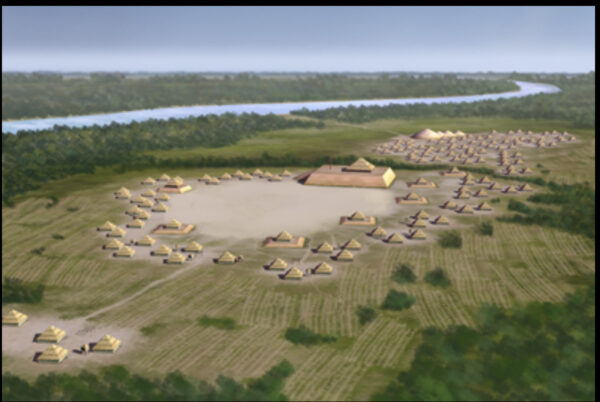
Aerial reconstruction of Spiro by H. Roe (2016), with Craig mound in the upper right. Photograph: Wikipedia.
The exhibition was organized by the National Cowboy & Western Heritage Museum in Oklahoma City, where it opened. I have learned much from the exhibition catalog Recovering Ancient Spiro: Native American Art, Ritual, and Cosmic Renewal (National Cowboy & Western Heritage Museum, Oklahoma City, 2020). It features contributions from 16 scholars. I refer to it below as RAS.
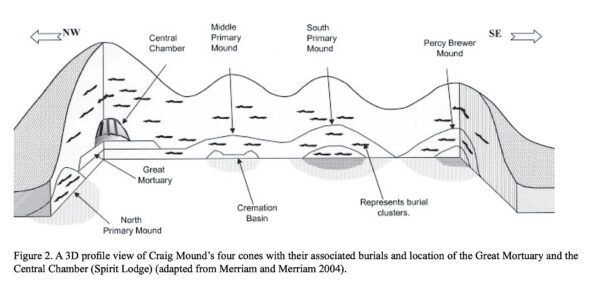
3D profile view of the four cones that make up Craig Mound. The central chamber in the large cone on the left is referred to in this article as Spirit Lodge. Photograph: Lambert, 2018 (adapted from Merriam and Merriam, 2004) in Caddo Archaeology Journal.
The modern day vandals who ravaged the site were treasure hunters, who incorporated themselves as the Pocola Mining Company and paid a fee for the right to dig from 1933-1935. Unfortunately, efforts earlier in the century to excavate the mound by professor Joseph Thoburn of the University of Oklahoma had been rebuffed by the landowner, who was a descendent of Choctaw freedmen. According to local lore spread by descendants of the Pocola miners, they believed the legend that Spanish conquistadors had discovered the gold of El Dorado and buried it in a mound in present-day Spiro. After all, what else could conquistadors do with a vast quantity of gold, send it to Spain or something? Not when they could bury it in what would have been — to the fortunate conquistadors — the middle of nowhere. But it seems the Pocola miners had incorporated it in order to search for Native American artifacts, which they planned to sell. Though, of course, what treasure hunters do not hope to discover some gold?

Three Pocola miners are digging in the cone labeled South Primary Mound in the chart illustrated above, c. 1934-35. They are (from left to right) in the foreground: Bill Vandagriff, Hayden Vandagriff, and K. A. McKenzie; the caretaker Dan is seated behind them; Chuck Aronhalt, a friend of Robert E. Bell, the photographer, is seated on the right. Photograph: spiromound.com.
As they searched for what they deemed to be saleable relics, the Pocola miners discarded vast quantities of important material, as well as the remains of the tribal leaders who had been buried in the area. Ultimately, the remains of 1,100 bodies were disinterred.
After many years of studying photographs, archaeologists were able to determine that Spirit Lodge was separate from the Great Mortuary (which contained generations of burials), and that the lodge was situated directly above the Great Mortuary. Local lore held that the Spanish compelled Native Americans to bury their golden treasure, and then killed them to keep its location secret. In any case, the more bodies the miners found, the more treasure — of whatever sort — they expected to find.
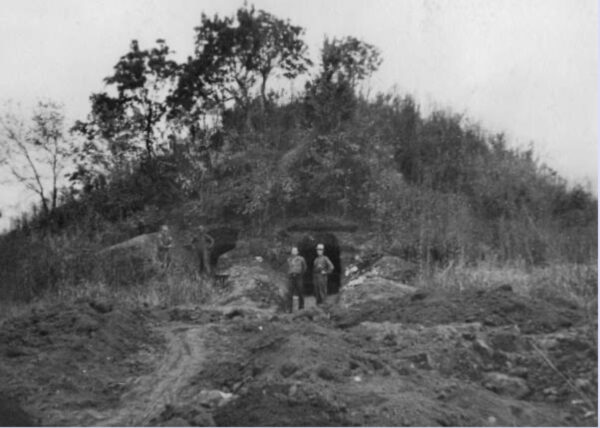
Large cone (looking northwest) with tunnels to the Spirit Lodge and diggers at the entrance, summer, 1935, photograph possibly by H. T. Daniel. Photograph: spiromound.com.
In 1935, the Oklahoma Antiquities Law was passed to prohibit these destructive, unauthorized excavations. It was Oklahoma’s first antiquities law. The miners were informed that their actions were now illegal. When the supervising archaeologist left Oklahoma to teach a class at U.C. Berkeley, the miners responded by redoubling their efforts. The Spirit Lodge chamber within Craig Mound was excavated with great and destructive haste. In the RAS introduction, Eric D. Singleton and F. Kent Reilly III say the site was subject to “one of the largest and longest episodes” of archaeological looting in U.S. history.
Thousands of Mississippian objects (including materials from as far away as California and Mexico) from around 1400 A.D. and earlier were inside of the Spirit Lodge chamber, which was reinforced by cedar poles and sealed with clay (probably clay bricks).

Kansas City Star front page, December 15, 1935.
After the Pocola contract had expired, some of the miners’ most prized finds were shown to the Kansas City Star. Dubbed “a ‘King Tut’ Tomb in the Arkansas Valley” (December 15, 1935), the newspaper opined: “recent discoveries… may be of almost equal historical significance, but are not yet recognized by any scientific organization.” The Star added: “Nor has any museum or wealthy earl come forward with financial support….” Without succumbing to Kansas City-style exaggeration, nothing quite like it has ever been found in the U.S.
In most accounts, it is stated that when their lease was about to expire, the Pocola miners blew up the chamber with dynamite or kegs of gunpowder. This was allegedly done to cover their tracks, and to spite the University of Oklahoma archaeologist Forrest E. Clements, who was instrumental in passing the antiquities law that prohibited such depredations. In early 1934, Clements surmised that Mississippian artifacts new to the art market had come from Spiro. He attempted — unsuccessfully — to dissuade the miners from digging. They also refused his offer to buy out their lease. At one time the looters were arrested, but they were never prosecuted for their crimes.
The authors of an essay in RAS demonstrate that the tunnel to the Spirit Lodge still existed after the Pocola lease expired. They propose that local farmers blew up the tunnel in order to stave off a potentially dangerous soil collapse, sometime between May and June of 1936. Thereafter, the W.P.A., in conjunction with other entities, undertook excavations of the Spiro Mounds between 1936 and 1941.

Large cone (looking west-southwest) during the W.P.A. excavation, c. 1938. Photograph: spiromound.com.
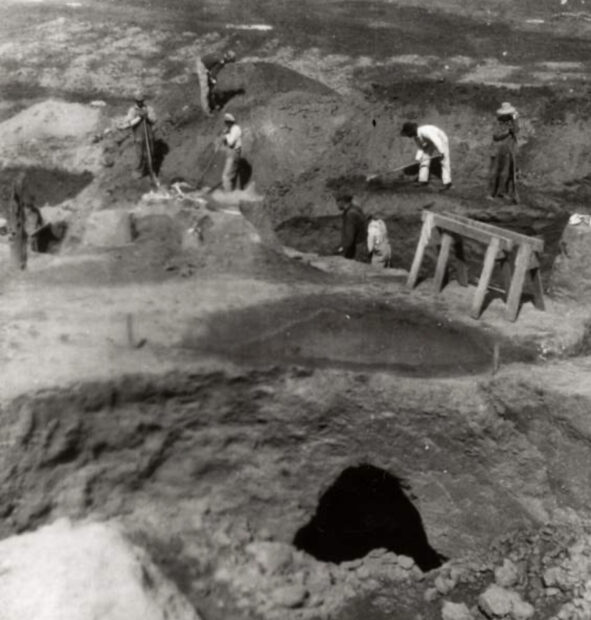
The large cone has been removed during the W.P.A. excavations in 1938. The tip of the Spirit Lodge is visible in the lower center. Photograph: spiromound.com.
Singleton and Reilly quote Clements, who noted (after Pocola had vacated the site): “it is impossible to take a single step in hundreds of square yards around the ruined structure without scuffing broken pieces of pottery, sections of engraved shells, and beads of shell, stone, and bone.” Clements also stated that cedar poles and fragments of fur and feather textiles were scattered about.
The Pocola looters, who had no appreciation for the rarest of these objects, destroyed numerous uniquely preserved works made of perishable materials that survived only because the chamber was effectively sealed. These extremely rare — and tragically temporary — survivals included: feathers, fur, hide, cloth textiles, and basketry. They included the precious regalia of the gods and numerous sacred bundles. If even one of these objects had been carefully protected and preserved, it would be regarded as a great treasure. Instead, we are left primarily with a few deteriorated fragments.
During the Pocola looting, a child was seen playing with a feather cape, which disintegrated before the witnesses’ eyes. The miners also discarded and crushed thousands of shells and other objects, dumping them in wheelbarrows and utilizing them as a makeshift sidewalk. Cedar logs that formed the symbolic tipi were burned for firewood. Curio seekers offered small change for archaeological objects. Chipped points that symbolized the souls of the departed were sold for a nickel.
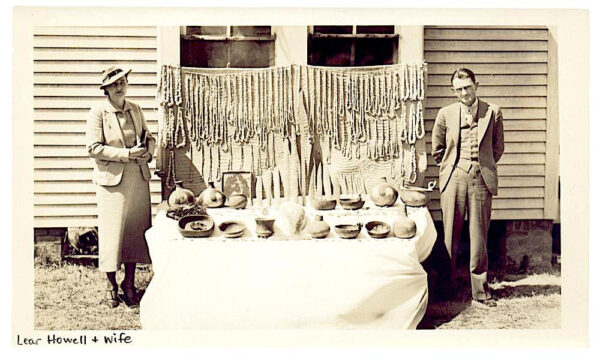
Lear Howell and his wife displaying artifacts from Spiro and other local archaeological sites, c. 1935 (only the beads are from Spiro). Photograph: spiromound.com.
The looters of the mound began selling objects from their automobile trunks on the roadside and at other locales, as well as via relic magazines. The artifacts were dispersed far and wide. This is why some of the more durable Spiro objects can be found in collections as distant and august as the British Museum, the Louvre, and the Hermitage.
The site was so rich that the archaeological material found after the sustained looting by the Pocola miners was nonetheless more substantial than that found at any other single Mississippian site.
Interpreting the Spirit Lodge
As an educational guide by the National Cowboy Museum notes about the Craig mound:
This singular site, which held the keys to understanding Mississippian iconography, religion, ceremony, and countless other social, political, and trade practices, will now always remain a partial mystery as there is no way to reassemble all the items that were sold or to place them in their correct context within the mound.
Fortunately, the Pocola pillagers made drawings and notes of some of the most significant objects they looted, as well as some of their find spots. This material — in conjunction with the objects that were tracked down — was ultimately enough to enable scholars to formulate a bold conjecture about the Spirit Lodge’s purpose.
After years of studying these notes and drawings, as well as excavation photographs, some archaeologists posited that the objects in the Spirit Lodge formed a tableau that mimicked the morning sky on the day of creation, which corresponds to our date of February 19, 634 A.D. The Little Ice Age had caused devastating droughts in the Eastern U.S. These droughts would contribute to the collapse of the large Mississippian ceremonial centers. Scholars theorize that the Spirit Lodge was fashioned for the purpose of restarting creation in order to stave off drought and save their civilization. The symbolic objects buried in the lodge contained the powers necessary for creation.
The main lines of the morning sky argument are illustrated and summarized in the lecture “Spiro Archaeological Site: Travels on the Path of Souls” by F. Kent Reilly III at the School for Advanced Research in Santa Fe in 2017.
Reilly notes that the study of excavation photographs enabled scholars to differentiate the Spirit Lodge from the Great Mortuary beneath it. He argues that the Spirit Lodge represents the sky world, and the mortuary beneath it the land of the dead.

Pawnee Star Chart, c. 1700, paint on tanned elk skin, Field Museum of Natural History, Chicago. Photograph: judyvolker.com.
In his lecture, Reilly discusses the Pawnee Star Chart, which represents stars and constellations (the latter represented as sacred bundles) on the afore-mentioned day of creation (our 634 A.D.).
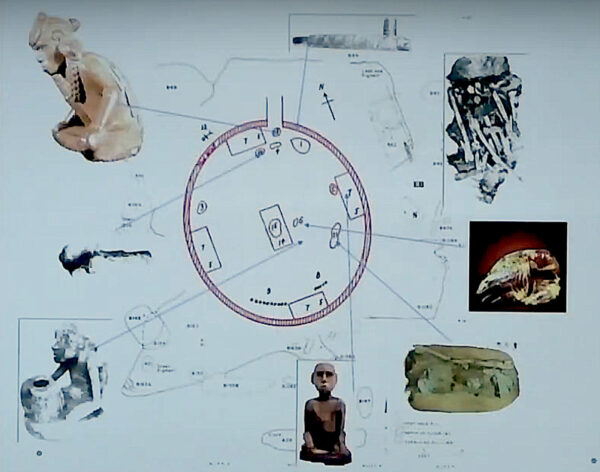
Drawing of Spirit Lodge floor with photographs of symbolic objects linked to their find spots. Photograph: screenshot from “Spiro Archaeological Site: Travels on the Path of Souls” lecture.
Reilly further explains that the symbolic objects were arranged within the Spirit Lodge to replicate the night sky on the day of creation.

Earthmother effigy pipe, stone, c. 1400 A.D., National Museum of the American Indian, Smithsonian Institution, Washington D.C. Photo: National Museum of the American Indian.
This Earthmother effigy pipe (illustrated in the lower left of the above chart) was situated near the center of the Spirit Lodge, by the Path of Ancestors (the Milky Way), which bisects the Pawnee Star Chart and the drawing of the Spirit Lodge that Reilly utilizes in his lecture.
Corn is one of the Earthmother’s manifestations, and this effigy holds a cob of corn with her left hand. She is connected with fertility and rebirth. The Skidi Pawnee called her Evening Star (Venus) as well as Earthmother.
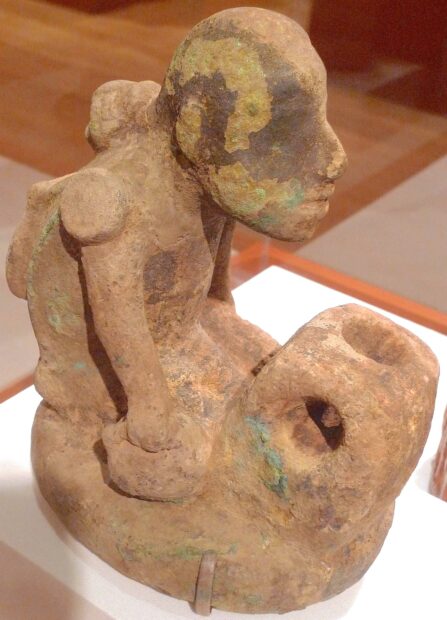
Earthmother effigy pipe found in the Spirit Lodge. Photo: Ruben C. Cordova.
The other side of the statuette.

Effigy pipe of seated male figure, known as Resting Warrior or Big Boy, and identified as Morning Star or the hero Red Horn, bauxite (flint clay), 1100-1200 A.D., University of Arkansas Museum. Photograph: The Nelson-Atkins Museum of Art, Media Services/John Lamberton.
This remarkable pipe effigy (in the upper left of the above chart) was found pressed into the wall of the Spirit Lodge where the Pocola miners tunneled into the chamber. It is a prime example of the Braden style associated with Cahokia, the largest of the mound cultures, near present-day St. Louis. The Braden style is characterized by naturalism and naturalistic proportions. In a RAS essay, Reilly calls this effigy “the most striking representation of Morning Star.” In his lecture Reilly says Morning Star may have been the major deity of Cahokia.
Morning Star was a god of primordial creation. He was also a war god who traversed the sky as a comet and, depending on the time of year, was either Venus or Mars in the night sky. According to the Pawnee, he was the bringer of fire, as well as the husband of Evening Star/Earthmother (illustrated above).
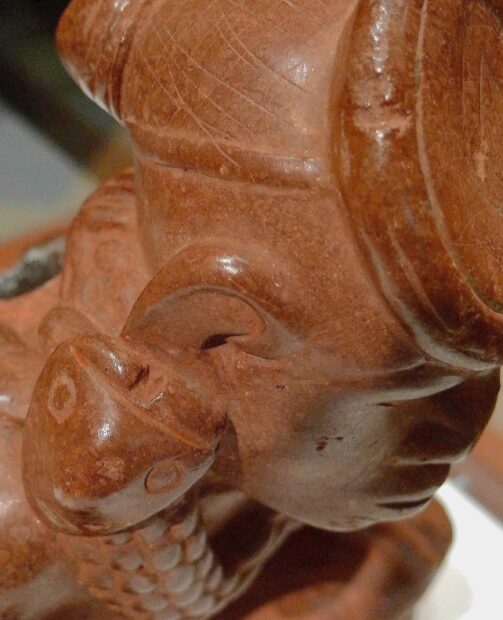
Effigy pipe of seated male figure, identified as Morning Star (detail with face maskette ear ornament). Photograph: Ruben C. Cordova.
This effigy wears Long-Nosed-God maskettes as ear ornaments. They probably represent one of the Hero Twins (who are discussed below). This figure, in fact, is sometimes referred to as he-who-wears-Long-Nosed-God maskettes. A pair of these ear ornament maskettes were also included in the Spirit Lodge: Mississippian Art from Spiro exhibition.
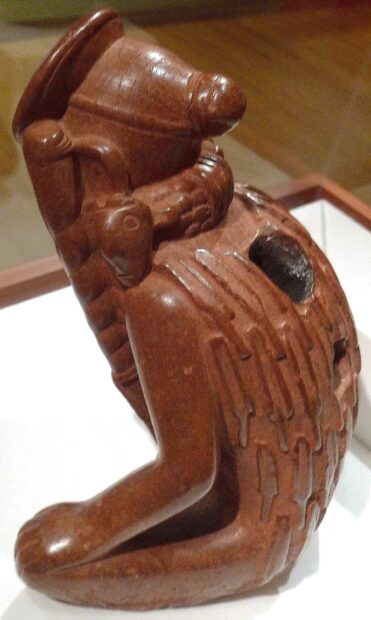
Effigy pipe of seated male figure, identified as Morning Star (view from side/rear). Photograph: Ruben C. Cordova.
From this view, one can see how the palette on the man’s forehead is attached by a chord that runs behind and around the bun on the back of his head. Just to the left of his ear, one can see that the large braid is not made up of his own hair, but is instead a piece of regalia that hangs from his head (it has also been identified as a horn). Note also the enormous size of the figure’s ear, as well as the large scale of the maskette that is attached to it. The enormous girth of the figure’s necklace is also evident from this view.
The forms on the figure’s back have been misidentified as part of a feather cloak, but in a RAS essay, Reilly notes that David Dye identifies it as a cloak made of raccoon pelts. Reilly also points out that the Pawnee, who speak the Caddo language, sometimes associate raccoon skins with clouds. Reilly draws this conclusion:
Symbolically, the cloak may represent the sky, with its welcome burden of storm clouds. On the object, the cloak is drilled so that the pipe bowl and stem hole for smoking are connected, perhaps even as the raccoon pelt cloak, burning tobacco smoke, and clouds are associated within this composition.
In Native American cultures, tobacco was “a primary ritual substance” because smoke enabled communication with spirits.
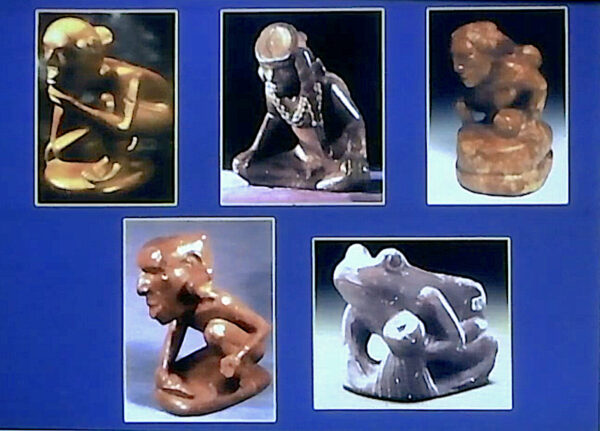
Braden-style statuettes as vignettes from the Morning Star Cycle. Photograph: screen shot from “Spiro Archaeological Site: Travels on the Path of Souls” lecture.
In his lecture, Reilly argued that pipe effigy statuettes in the Spirit Lodge enact the Morning Star Cycle myth, which he compares to the Christian Stations of the Cross.
All in all, this concerted effort to restart creation at Spiro must have been an enormous — and likely unprecedented — intervention into the workings of the cosmos, driven, as it was, by utter desperation for water.
James A. Brown, Alex W. Barker, and George Sabo III conclude in a RAS essay that Spirit Lodge rites enacted by Spiro priests:
may well have effected a wholesale transformation in the cosmological framework for addressing large-scale problems that involved a shift from dependence on ancestral inheritance to active interaction with the very forces responsible for the creation of their world.
This transformation might be symbolized by the placement of the Spirit Lodge above the Great Mortuary.

Obsidian trade route map. Photograph: screenshot from “Spiro Archaeological Site: Travels on the Path of Souls” lecture.
Spiro was an important religious and trade center. Reilly notes in his lecture that none of the objects deposited in the Spirit Lodge are certain to have originated in Spiro. The Craig style of engraved shells (found in the Southern U.S.) is characterized by Alex W. Baker the catalog as “robust and schematized.”
It is possible that delegations from other ceremonial centers actively participated at the dedication of the Spirit Lodge, bringing their own precious objects, some of which were ancestral heirlooms.
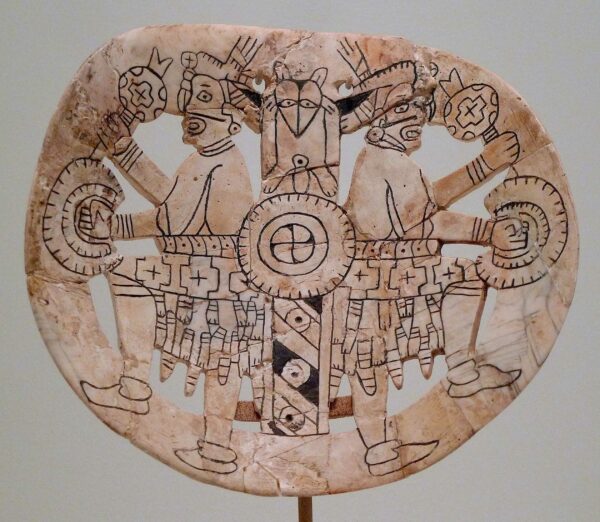
Engraved gorget with dancing figures, Craig style, c. 1200-1450, marine shell, Woolaroc Museum and Wildlife Preserve, Bartlesville, Oklahoma. Photograph: Ruben C. Cordova.
The two dancing figures (who wear headdresses and hold rattles and drums) circle a pole representing the axis mundi (Tree of Life) that connects the three vertical layers of the Mississippian cosmos. It is a portal that facilitates movement between worlds. Note that a raccoon sits atop the axis mundi.
I wondered whether these dancers might allude to the Hero Twins, who were part of a religious belief system that stretched from parts of North America to the Maya in Central America, whose exploits are recounted in the Popul Vuh. In a RAM essay, Reilly prefers to refer to them by the designation other-than-human-persons (OTP).
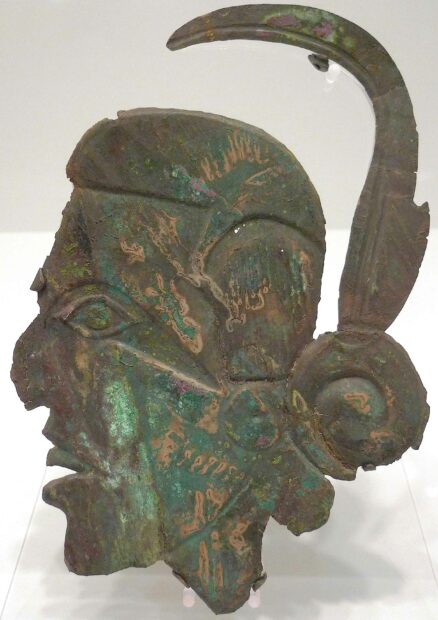
Embossed Human Head Effigy Plate, c. 1200-1450 A.D., copper, Ohio History Connection. Photograph: Ruben C. Cordova.
This copperhead is thought to refer to a decapitated Hero Twin. Copper was sourced from the Great Lakes region.

Three Axes and three Maces, c. 1200-1450 A.D., stone, Gilcrease Museum, Tulsa, Oklahoma. Photograph: Ruben C. Cordova.
These extraordinary and rare ritual weapons were all fashioned from a single piece of stone. Used in ceremonies by members of secret medicine societies, they were associated with deities, particularly the Hero Twins, who, along with Turtle and Morning Star, battled various supernatural beings.
Conclusion
Recovering Ancient Spiro was organized in consultation with the Caddo Nation and Wichita and Affiliated Tribes, who are the descendants of the Spiroan people. Additionally, as Reilly notes in the lecture linked above, an understanding of the function and symbolism of the caches made in the Templo Mayor in Mexico City provided insights that were helpful in analyzing the Spirit Lodge and the significance of the specific positioning of the ritual objects inside of it.
As is evident from the above discussion, trade and religious and cultural practices connected many distant Native communities in ways that are still being assessed and understood. Recovering Ancient Spiro is the product of a community of scholars who have undertaken a more global examination of Native American cultures. This approach has provided insights, analytic tools, and parallels with various linked communities that have enabled these scholars to overcome the destruction wreaked by the Pocola miners. This exhibition and catalog constitutes a triumph of learning over conditions imposed by looting, vandalism, neglect, oppression, and genocidal practices that have afflicted Native American communities in the U.S. and elsewhere. They will no doubt contribute to future insights and discoveries pertaining to Native American cultures.
***
Ruben C. Cordova is an art historian and curator who reviewed Van Gogh’s landscapes at the Dallas Museum of Art.



3 comments
Good article on this history. Some curiosity questions:
First, did the owner of the land, who was a Choctaw freedman, (for clarification/definition in case anyone is not aware: Choctaw freeman were African Americans who were emancipated and granted citizenship in the Choctaw Nation) receive the “fee” paid by the Pocola miners who named themselves the “Pocola Mining Company”?
Second/Third question: did the owner of the land document reasons why he rebuffed Joseph Thoburn of the University of Oklahoma to excavate the area? Is the owner’s name known?
Thank you
WoW
Sue,
Sorry I did not see your comment till now.
The introductory catalogue essay by Singleton and Reilly states that Thoburn identified the mound in 1914, that it was part of the Choctaw Nation land allotment, and that the Spiro site was divided into at least four allotments dispersed to Choctaw freedmen. They add: “At this time, the owners forbade all digging on the property…. By 1933, however, the restriction was reversed” because of the need for money. Elsewhere it has been speculated that there was a desire not to disturb human remains buried on the property. In another catalogue essay by three other authors, it is stated that George Evans, the legal guardian for the Craig children (who were then the owners of the property), signed the Pecola lease.
According to 405 Magazine (2013), the Choctaw did not disturb the mounds. Forced to dissolve their tribal government and assign the lands to individuals, they assigned the area to freedmen. Rachel Brown was the first owner after statehood, and William Craig inherited the land with the mounds from her, which he willed to his grandchildren. George Evans was their maternal grandfather, and the lease money ($300) was used to pay his mortgage and for medical treatment for a grandson with tuberculosis.